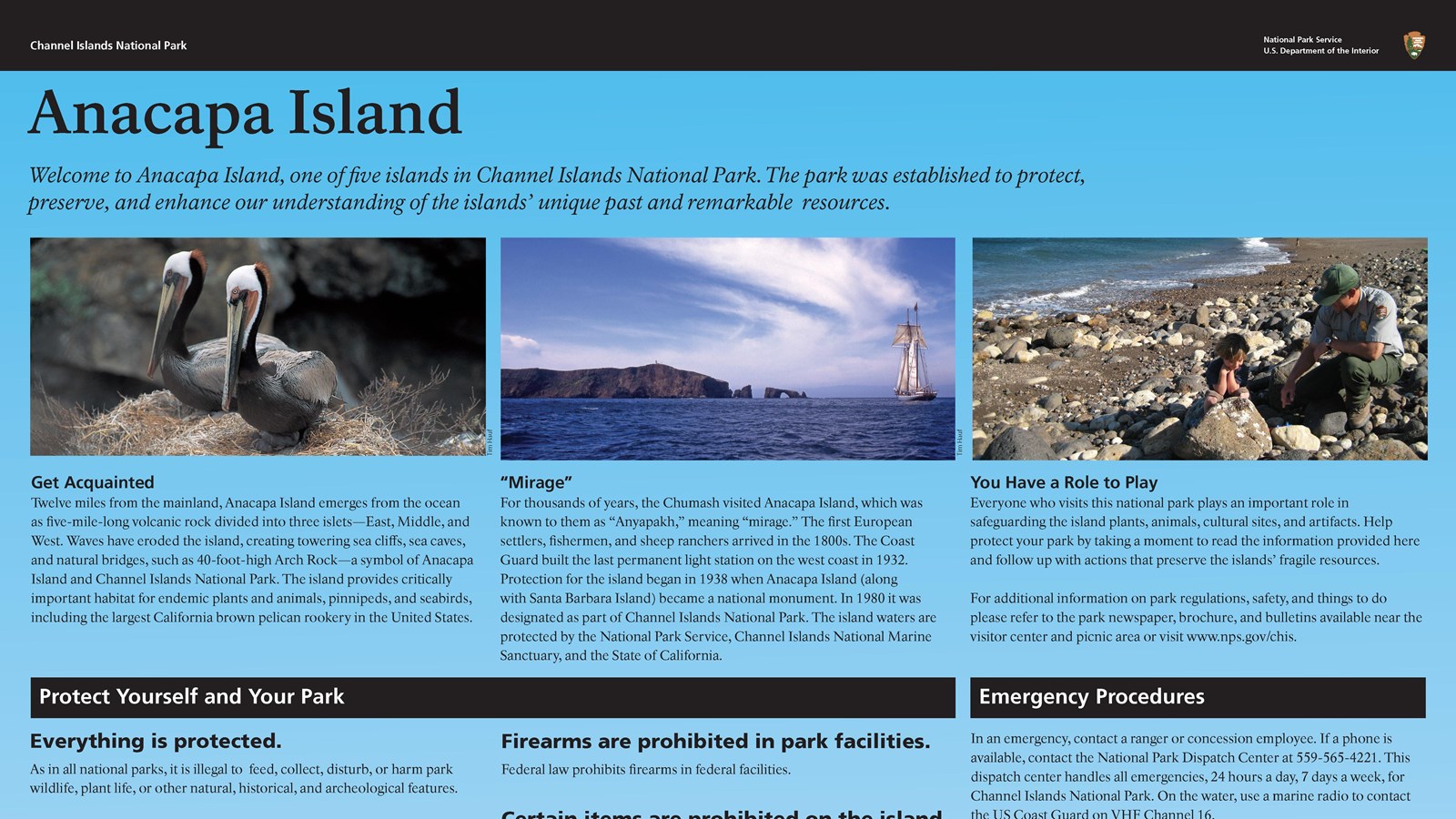Last updated: May 6, 2021
Place
Sign: Anacapa Landing Dock Welcome Information

Information
Welcome to Anacapa Island, one of five islands in Channel Islands National Park. The park was established to protect, preserve, and enhance our understanding of the islands' unique past and remarkable resources.
Get Acquainted
Twelve miles from the mainland, Anacapa Island emerges from the ocean as a five-mile-long volcanic rock divided into three islets-East, Middle, and West. Waves have eroded the island, creating towering sea cliffs, sea caves, and natural bridges, such as 40-foot-high Arch Rock-a symbol of Anacapa Island and Channel Islands National Park. The island provides critically important habitat for endemic plants and animals, pinnipeds, and seabirds, including the largest California brown pelican rookery in the United States.
"Mirage"
For thousands of years, the Chumash visited Anacapa Island, which was known to them as "Anyapakh," meaning "mirage." The first European settlers, fishermen, and sheep ranchers arrived in the 1800s. The Coast Guard built the last permanent light station on the west coast in 1932. Protection for the island began in 1938 when Anacapa Island (along with Santa Barbara Island) became a national monument. In 1980 it was designated as part of Channel Islands National Park. The island waters are protected by the National Park Service, Channel Islands National Marine Sanctuary, and the State of California.
You Have a Role to Play
Everyone who visits this national park plays an important role in safeguarding the island plants, animals, cultural sites, and artifacts. Help protect your park by taking a moment to read the information provided here and follow up with actions that preserve the islands' fragile resources.
For additional information on park regulations, safety, and things to do please refer to the park newspaper, brochure, and bulletins available near the visitor center and picnic area or visit www.nps.gov/chis.
Protect Yourself and Your Park: Rules and Regulations
Everything is protected.
As in all national parks, it is illegal to feed, collect, disturb, or harm park wildlife, plant life, or other natural, historical, and archeological features.
Hike only on designated trails.
Visitors are required to use the designated island trail system. No off-trail hiking is permitted. Visitors should stay back from cliffs and should not rock climb as the cliffs and rock faces are very unstable. For more information on island hiking please refer to the park newspaper and the trail guide available near the visitor center and picnic area
Remove your garbage.
Visitors are required to pack out what they pack in, including garbage, and to secure their food and trash from birds and animals at all times.
No pets.
Domestic house pets can carry diseases that could harm the rare island fox or other animals that are unique to the island. Service animals require a permit from the park superintendent.
No campfires or charcoal fires.
Due to extreme fire danger, no campfires or charcoal fires are permitted on the island. Use only enclosed gas campstoves for cooking.
No smoking.
Smoking is allowed only on the concrete area by the crane at the top of the stairs. Please take cigarette butts off the islands with your other trash.
Firearms are prohibited in park facilities.
Federal law prohibits firearms in federal facilities.
Certain items are prohibited on the island.
To protect park resources and prevent the introduction of nonnative species the following items may not be brought to the park: live or potted plants; soil; cut flowers; firewood or any untreated, unfinished wood (including hiking sticks); corrugated boxes; tools or equipment with attached soil; motorized vehicles; bicycles; and single-use plastic grocery bags.
No landing on offshore rocks.
Landing is not permitted on offshore rocks and islets. In addition, West Anacapa (except at Frenchys Cove) and Middle Anacapa are closed to protect seabirds.
No fishing within Marine Reserves.
Marine Protected Areas, including Marine Reserves and Marine Conservation Areas, are found throughout the park, marine sanctuary, and state waters. Within these areas it is unlawful to injure, damage, take, or possess any living, geological, or cultural marine resource. Limited harvest is allowed in Marine Conservation areas.
Avoid contact with deer mice.
Hantavirus has been found in island deer mice. Contact your physician if you experience flu-like symptoms after contact with deer mice or infected materials. This is a life-threatening illness.
Be aware of boat departure times.
When departing the island, visitors are responsible for meeting the boat on time. Ask the ranger or concessioner for departure times.
Emergency Procedures
In an emergency, contact a ranger or concession employee. If a phone is available, contact the National Park Dispatch Center at 559-565-4221. This dispatch center handles all emergencies, 24 hours a day, 7 days a week, for Channel Islands National Park. On the water, use a marine radio to contact the US Coast Guard on VHF Channel 16.
Things to Do
Anacapa Island is the perfect place for a variety of activities including hiking, camping, swimming, snorkeling, kayaking, and wildlife and wildflower viewing. Please refer to the park newspaper and brochure available near the visitor center and picnic area for detailed information.
For self-guided interpretive information on Anacapa Island, please refer to the East Anacapa Trail Guide available near the visitor center and picnic area.
For bathrooms, trail maps, and more information about camping, hiking, and watersports, please follow the stairs and trail to the Anacapa Island visitor center.
